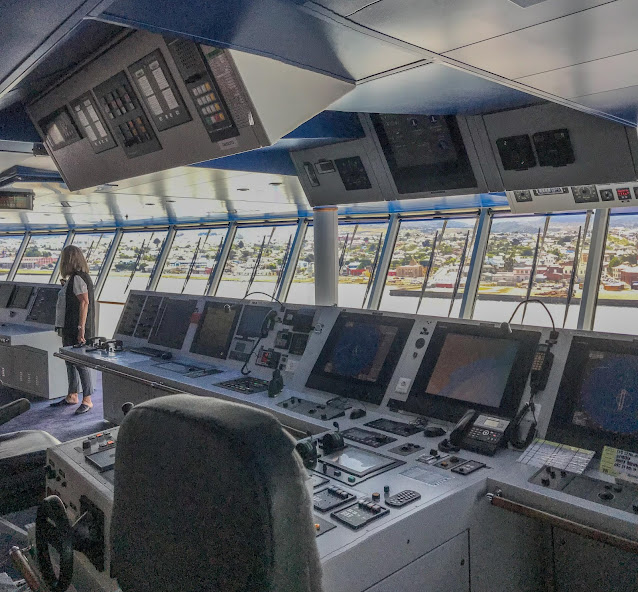Puerto Montt
This is the Los Lagos region, the Lake District of Chile on the edge of the Patagonian wilderness. We are now just over a thousand kilometres south of Santiago, our final destination.
 |
centre/left where the solid white line
becomes dots is Petrohue Falls, our destination The Osorno is one of twelve active volcanoes in the region. It dominates the landscape from a very long way off. |
Lake Llanquihue is the largest lake in Chile
 |
| Lady of Puerto Varas |

We did a half-day excursion on a nice small bus with about a dozen fellow passengers, guided by a young local Chilean woman.
Maria's English was terrific. She was just completing (on scholarships) her Master's Degree in Linguistics and will be starting her doctoral programme in Germany in the fall.
 |
| the dozen buses reserved by the Marina for shore excursions |
We pre-booked online with ViaTour for about one-fourth the price of the Marina's excursion.
Our tour was like a Sunday outing with some new friends.
Lunch was a picnic.
(more on that below)

mingling with
sleeping dogs and sleepy-eyed alpacas
 |
some of us rubbed noses with the alpacas
|
In the mid-1800s Chile's President Manuel Montt opened up this remote, heavily forested region of the country with immigration and resource development, bringing in a wave of German settlers. Their influence remains today. Following the cleanup of a cataclysmic earthquake in 1960 Chileans from around the country began to relocate here.
Frutillar was settled by German colonialists. The Teutonic flavour of the town was reported in the brochure to be rather Bavarian. We did not see anyone walking around wearing lederhosen and grey wool sweaters with pewter buttons, but there was some decidedly Deutsch architecture. Having been to the fatherland many times I left the photos of the "Bavarian" buildings for other tourists.
On the bottom floor of this old wood frame building, there is a delicatessen that keeps some of the German food culture alive. We chose to forgo the Würstchen, Sauerkraut, the Kuchen and the Strudel for the empanadas that were waiting at our next stop.
Puerto Varas, on the shore of Lake Llanquihue, is known as the Rose Capital of Los Lagos. The temperate climate, abundance of rainfall, and fertile land support important agricultural industries in this region.


While the city rose gardens were near the end of their bloom, they were still stunning and I managed to preserve some of them in photographs.
Our picnic of empanadas and wine was waiting for us. Our small group feasted at the lakeshore amongst the wildflowers. It was T-shirt weather.
 |
| our guide, Maria served us white and red wine |
This Cabernet Sauvignon is also available at home with a different label—great picnic and everyday table wine. Of course, the price is much higher in BC. Concha Y Toro is a big wine producer in Spain. One of the Iberian sons took the family label to the new world and made a success of it in Chile.
On our return to the ship, Maria dropped just the two of us off a few blocks from the dock so we could buy some of the same CabSav at a local corner store. Not a place for tourists. All the better. We bought the litre and a half for our cabin for just a few dollars: what the locals pay.
 |
| last tender back to the ship |
 |
| Adib, Barista extraordinaire |
Safe and sound, we were back on the mother ship in time for my daily cappuccino prepared by Adib, our Barista extraordinaire!
Then, I seem to recall opening the vino tinto ...
...ooo0ooo...























































